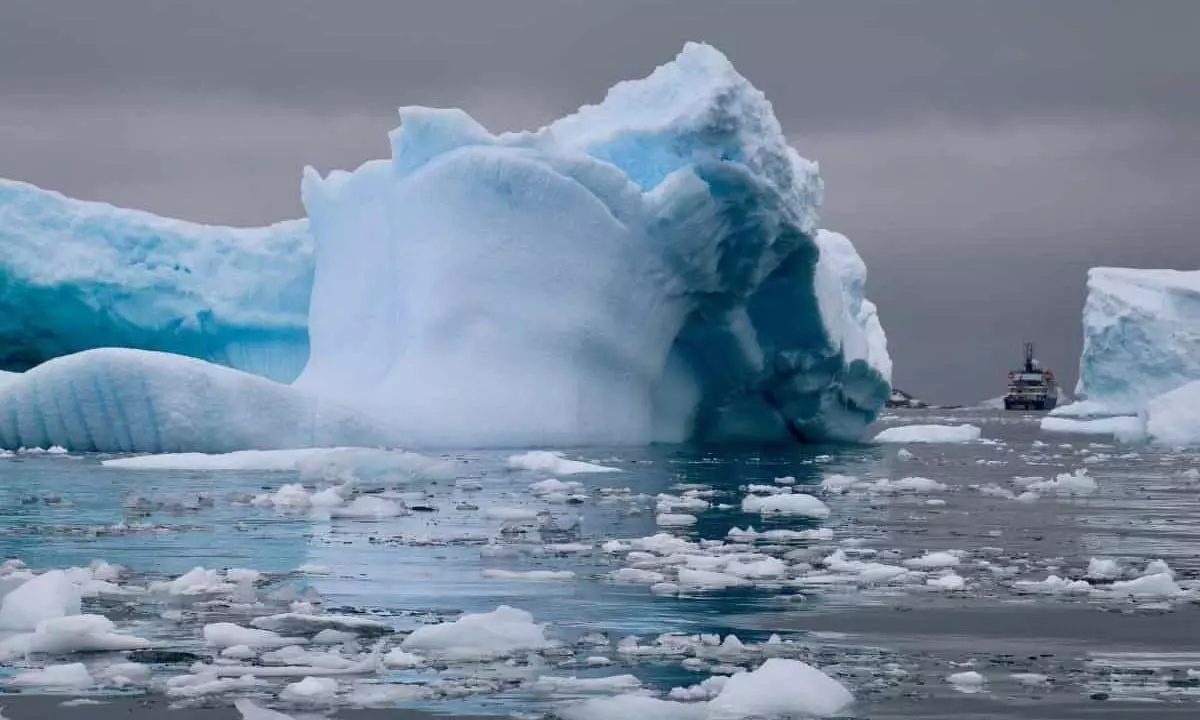Antarctic ice continues to melt

Antarctic ice continues to melt
Our new research in the Antarctic suggests that the vital layer of cold water on the sea bed, which circulates the globe and influences the ocean’s ability to continue absorbing much of the rise in atmospheric heat and greenhouse gas emissions, is heating up and shrinking
Our new research in the Antarctic suggests that the vital layer of cold water on the sea bed, which circulates the globe and influences the ocean’s ability to continue absorbing much of the rise in atmospheric heat and greenhouse gas emissions, is heating up and shrinking. Much of this is a result of human-made climate change, which is melting Antarctic ice shelves and disrupting the complex system that controls this circulation.
But it appears, as far as the past 30 years are concerned, a natural cycle may have been partly responsible for the changes observed. The ocean has absorbed more than 90% of the excess heat and around 30% of the extra carbon dioxide humans have generated since the start of the industrial age. This has greatly reduced the impact of climate change at the Earth’s surface where we live. Most of this exchange of gases and heat between the atmosphere and the ocean happens in the Southern Ocean around Antarctica through the complex vertical movement of water. One of the biggest drivers of this vertical movement is the production of what oceanographers call Antarctic bottom water. Around the Antarctic coastline, seawater near freezing point contacts the much colder air and freezes into sea ice, expelling salt and consuming freshwater to leave cold, salty and dense water. The vast majority of this dense water is produced at only a few locations around Antarctica. In these places, wind blowing off the frigid continent continually pushes newly formed sea ice away from the surrounding ice shelves to create areas of open water known as polynyas. These polynya ice factories produce great volumes of cold and salty water which cascade down Antarctica’s continental slope like a submarine waterfall to the ocean bottom.
Once there, Antarctic bottom water, the world’s deepest and densest water mass and the biggest of its kind, spreads around the globe, storing carbon from the atmosphere for hundreds or even thousands of years. As Antarctic bottom water moves north along the sea floor it drives the great ocean conveyor, also known as the overturning circulation: currents that redistribute heat, carbon and nutrients around ocean basins and regulate the global climate.
Our new research used observations from ships and satellites to reveal that the bottom water volume in the Weddell Sea, the Atlantic sector of the Southern Ocean and one of the biggest producers of this water mass, has decreased by more than 20% over the past 30 years, causing the deep Weddell Sea to warm four times faster than the global average. Our evidence suggests weakening offshore winds in the region are to blame for polynyas shrinking and making less of the cold, dense, salty water which feeds Antarctic bottom water and drives the global ocean conveyor. This could slow down the deep overturning circulation, with profound implications for the climate system.
Previous studies have linked the slowing global ocean conveyor with less cold, dense water forming in the Southern Ocean due to increasing meltwater from ice shelves. While man-made climate change is significant, our new research suggests that natural variability in wind and sea ice are also important.
What’s up with the wind in the Weddell Sea? Weaker winds blowing offshore in the southern Weddell Sea over the past 30 years have limited the size of the coastal polynya, which in turn has produced less sea ice. We found that this change in the wind seems to be linked to surface temperature changes over the tropical Pacific during the same period, part of a natural cycle similar to El Niño, known as the Interdecadal Pacific Oscillation. Oscillating sea surface temperatures in the tropical Pacific are strong enough to affect the local air pressure and even influence the wind on both sides of the Antarctic peninsula. Although our study suggests that changes in the Weddell Sea are a result of natural variability in the Earth system, they are also part of an Antarctic-wide trend that is not as clearly explained by natural causes. In fact, freshening and shrinking bottom water is consistent with scientific predictions about the melting ice sheet.
Satellite observations have shown a steady loss in ice sheet mass since 2002. More and more evidence indicates that the Antarctic ice sheet is vulnerable to the warming climate and that the melting of this great reservoir of ice will disrupt the overturning circulation that extends throughout the global ocean. This will disrupt the climate and accelerate sea-level rise globally.
As scientists who study the complex interaction between the ocean, ice sheet and atmosphere around Antarctica,
we hope that continuing to refine our understanding of the Earth system and future climate projections will help inform decision makers. Systematic efforts are needed to immediately reduce greenhouse gas emissions and slow the pace of global warming.
(The Conversation)














